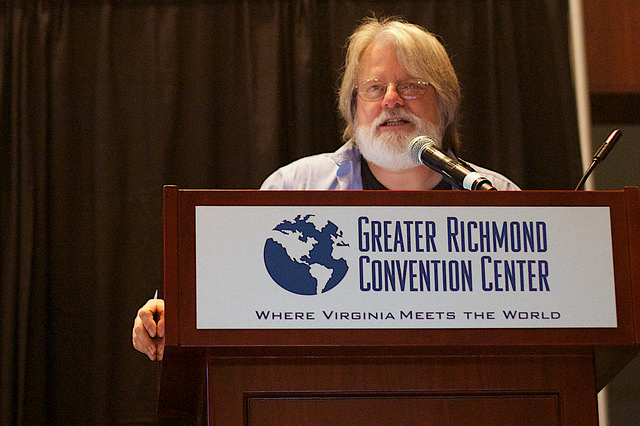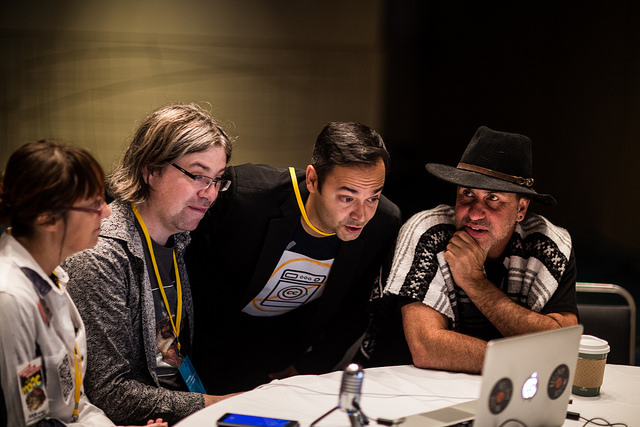This article is more than 5 years old.
I’ve been inspired for a long time by the work being done in the Open Education community. For the uninitiated, “Open Education” is an umbrella term that applies the principles of openness (think open access scholarship, open source software, etc.) to learning materials specifically and pedagogy and institutional practices more broadly. If you’ve heard of Open Educational Resources (OER), that’s a crucial part of it, but not all of it. The Open Education community was doing MOOCs before MOOCs went all corporate.
So, being curious about ways to incorporate more open education practice into my faculty support role, I sought out conference opportunities. I was thrilled to see that the annual Open Education Conference (#OpenEd16 from here on out) was a short drive away in Richmond, and that it boasted a killer lineup, including some of my personal heroes from the worlds of openness and online learning. Brenda Knox in Online Education agreed to fund my trip–many thanks to her!

The textbook problem
Much of the discussion around OER centers on the issue of affordability, and it’s no wonder why: textbooks are obscenely expensive. The cost of a college textbook has gone up 73%–four times the rate of inflation–over the last decade (which surprises exactly no one in acquisitions). It’s so bad, in fact, that 65% of students admit to having forgone purchase of a course textbook because of the price, even though 94% of those knew doing so would likely hurt their grade. So, replacing traditional textbooks with low- or no-cost alternatives like library licensed materials, open textbooks, or OER is a good way to save students money and ensure everyone gets the content. That’s totally noble, and it’s having a huge impact at large state institutions and community colleges, which report mind-boggling savings as a result of their OER initiatives (and, in some cases, entire OER degrees). Saving students money is great–they can take more courses, study abroad, pay rent, and actually buy the traditional books they are required to buy with that money they’re saving.
But.
OER is a tough row to hoe at Wake Forest. Fully two-thirds of our undergraduates pay full freight, so “affordability” means something very different than it does at Forsyth Tech. We shouldn’t ignore textbook costs, obviously, but it’s clear that the majority of our students *can* afford their books, even if they don’t always actually buy them. But I knew there were more compelling reasons to care about open education, so I sought them out. And I found them at #OpenEd16.

The entire conference felt subversive. It was a powder keg of technologists, researchers, faculty, librarians, instructional designers, and leaders of nonprofits, all brimming with energy. Its “proceedings” is a Google Doc called the “Archive of Awesomeness” (apologies to actual archives). The conference organizer rented a drum kit, guitars, and other instruments and sponsored an open jam session in the hotel lobby. For real. It was messy and flexible and organic and the boxed lunches weren’t terrible. I had found my people.
Some notable projects
Librarians were highly visible at #OpenEd16, for what I gather was the first time. I heard from many of them. One of the more notable presentations came from our friends at NCSU. Their Alt-Textbook Project is driven by lots of data (that’s so NCSU!) to target high impact courses for textbook replacements: those in the top 25% of enrollment, textbook cost, and course reserves usage. It saved students more than $250,000 in its first year. Yowza.
A workgroup sponsored by the Open Textbook Network, many of whom are librarians at their respective institutions, presented on a great initiative to make it easier for average users to modify open textbooks. They published their guide as an open text on Pressbooks (a tool that I saw in use over and over).
Speaking of tools, I learned more about hypothes.is, an open source collaborative web annotation tool that has gotten a lot of attention in the Open Education community. It essentially puts an annotation layer (for highlighting, commenting, discussing) on top of whatever web page or web-hosted document you want, through a browser extension or a special URL. You can see what I mean by annotating this exact blog post here. Those who use it with their classes say it transforms the act of reading the web (or online course texts) into a dynamic, public, dialogic experience for their students.
There was also a lot of buzz about the launch of REBUS, a collaborative community for producing open textbooks. Check out their community forum as well as their community press (again, Pressbooks).
So much of Open Education has to do with increasing access to education, both through making education available to learners from diverse backgrounds but also accessible to learners with diverse preferences and abilities. On that front, I heard from the developers of FLOE (Flexible Learning for Open Education), which produces tools designed to create a “one-size-fits-one” experience for learners. Check out this demo of their amazing “Learner Options” tool to get an idea of what they’re trying to do.
The main takeaway
If there was a conference theme (there wasn’t), it was “Beyond Affordability.” Almost every session I attended went way beyond the question of student cost savings. The focus, rather, was on the affordances of openness–what open content allows us to do in the classroom. Think of it this way: if the content we use in a class comes with permissions to retain, reuse, revise, remix, and redistribute it, we can do almost anything. We can make our own custom course packs and distribute them online for free, without worry. We can have our students chop up the textbook and annotate it in groups. But what if we encouraged our students to create open content? They call that open pedagogy. Our students can publish entire openly licensed anthologies that, in turn, become the course text for future sections and for courses at other schools (read the story behind The Open Anthology of Earlier American Literature here). We can have our students create the actual assignments that themselves are reusable, like they do in #DS106. With open pedagogy, students create and build upon openly-licensed content, and the resulting content lives beyond the course and gives value to the greater community. I heard repeated over and over the idea that opening up one’s course, first by replacing traditional content with OER, and then going further by experimenting with open pedagogy, is a transformative experience for faculty and students alike. You simply can’t do these kinds of things with traditional textbooks.
Why should WFU care?
I’ve written far too much at this point, and I haven’t even mentioned the amazing keynotes (Sarah Goldrick-Rab was a highlight), but suffice it to say that this conference changed something significant for me. I can’t unlearn what I learned. What I was looking for by attending #OpenEd16 was a way to articulate an answer to the question: why should Wake Forest care about open education?
The answer? Well, I hesitate to say it because it’s so darned cliche, but the reason we should care about open education at Wake is because we like to call ourselves a place that values exceptional teaching, a place that understands its social responsibility, a place that sees itself as a leader among institutions of its kind. We should care about open education because openness empowers teaching, because openness transforms learning. Because openness is sharing, and sharing serves humanity.

8 Comments on ‘Kyle at #OpenEd16, or: why WFU should care about Open Education’
Awesome stuff-takes me back to the good ol days. Power to the people (textbook)!
Thank you, Kyle, for attending this conference and sharing what you learned, along with these useful resources. I am especially appreciative of your characterizing the theme of the conference as “Beyond Affordability.” What a great way to frame our talks with faculty, and to envision our next steps toward Open Education here at Wake.
This sounds incredible! I love the part about “open pedagogy,” it reminds me of what Mary Dalton is doing with her critical media studies series, containing the content created by her students!
So… MOOC hipsters? Thank you for the apology to archives because Google Drive is no archive (shakes fist at it). And I love and appreciate your final conclusions about why we should care. That’s always the question, and the conclusion that openness = Pro Humanitate is a great, valuable answer!
Also, Gardner Campbell is a Wake alum, if you didn’t know
Hypothes.is is a game changer! Thank you for so eloquently summing up my own feelings on the why we should pursue open textbooks. It is just the right thing to do.
Kyle, I am grateful you were able to attend #OpenEd16 and bring these insights back to campus! As I’ve long commiserated with you, the “save students’ money!” angle of OER promotion doesn’t hold sway at Wake the way it does elsewhere (at least not for the majority), but harnessing the opportunities for innovative teaching and learning might. Hu rightly notes that we have faculty who are skirting the edges of open ed with projects they’ve already introduced…hopefully Carrie, Ben, you, me, Brenda, Allen, and all the rest of us can help them move forward with confidence!
Thanks for the thoughtful comments, everyone!
@Hu: I was thinking of Mary’s efforts almost every time someone mentioned Open Pedagogy. Our faculty see the value in it, even if they don’t have a name for what they’re doing. Empowering students to be experts and produce content is a truly inspiring thing!
@Carrie, Molly: Looking forward to focusing my efforts in this area in 2017. You’ll both be invaluable partners!
@Stephanie, Mary-Beth: It just makes sense, right? We enjoy quite a bit of privilege at WFU–leveraging this by sharing what we create is right in line with our Pro Humanitate ideals. (And yes, Stephanie–I should’ve mentioned Gardner’s WFU connection!)